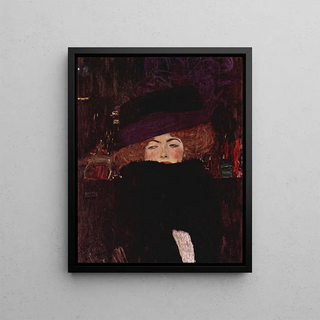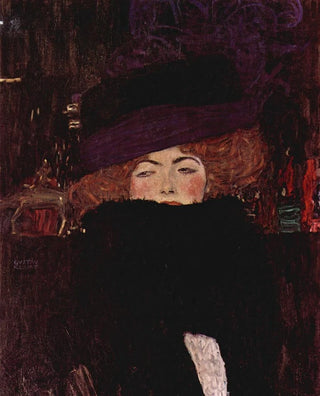Art print | Lady with Hat and Feather Boa - Gustav Klimt


View from behind

Frame (optional)
Introduction captivante
The "Lady with a Hat and Feather Boa" art print by Gustav Klimt is much more than a simple artwork; it is a true invitation to immerse oneself in the fascinating universe of the early 20th century. This iconic piece, which captures the very essence of feminine beauty and elegance, evokes an atmosphere of mystery and sophistication. Klimt, master of symbolism and ornamentation, manages to transcend reality by offering an idealized vision of women, while skillfully playing with light and patterns. The art print of this work allows for appreciating every detail, every nuance of color, and feeling the emotion it conveys.
Style and uniqueness of the work
Klimt's style is inimitable, blending Byzantine influences and Art Nouveau. In "Lady with a Hat and Feather Boa," the artist uses floral motifs and rich textures that envelop the subject in an aura of mystery. The woman, with a delicate face, is highlighted by an extravagant hat and a feather boa that seem almost alive. The vibrant colors, ranging from shimmering golds to darker shades, create a striking contrast that immediately draws the eye. The composition is carefully balanced, with each element arranged to guide the viewer's gaze toward the protagonist's face. This meticulous attention to detail makes the work a perfect example of Klimt's art, where every brushstroke is charged with meaning and emotion.
The artist and his influence
Gustav Klimt, an emblematic figure of the Viennese Secession movement, knew how to mark his era with his boldness and creativity. Born in 1862, he developed a unique style that challenged the conventions of his time. Klimt was interested in psychology and human emotion, which is reflected in his often introspective portraits. His ability to capture feminine beauty and explore themes such as love, sexuality, and death influenced many artists, both contemporaries and successors. His artistic approach, both decorative and symbolic, paved the way for a new understanding of the

Matte finish

View from behind

Frame (optional)
Introduction captivante
The "Lady with a Hat and Feather Boa" art print by Gustav Klimt is much more than a simple artwork; it is a true invitation to immerse oneself in the fascinating universe of the early 20th century. This iconic piece, which captures the very essence of feminine beauty and elegance, evokes an atmosphere of mystery and sophistication. Klimt, master of symbolism and ornamentation, manages to transcend reality by offering an idealized vision of women, while skillfully playing with light and patterns. The art print of this work allows for appreciating every detail, every nuance of color, and feeling the emotion it conveys.
Style and uniqueness of the work
Klimt's style is inimitable, blending Byzantine influences and Art Nouveau. In "Lady with a Hat and Feather Boa," the artist uses floral motifs and rich textures that envelop the subject in an aura of mystery. The woman, with a delicate face, is highlighted by an extravagant hat and a feather boa that seem almost alive. The vibrant colors, ranging from shimmering golds to darker shades, create a striking contrast that immediately draws the eye. The composition is carefully balanced, with each element arranged to guide the viewer's gaze toward the protagonist's face. This meticulous attention to detail makes the work a perfect example of Klimt's art, where every brushstroke is charged with meaning and emotion.
The artist and his influence
Gustav Klimt, an emblematic figure of the Viennese Secession movement, knew how to mark his era with his boldness and creativity. Born in 1862, he developed a unique style that challenged the conventions of his time. Klimt was interested in psychology and human emotion, which is reflected in his often introspective portraits. His ability to capture feminine beauty and explore themes such as love, sexuality, and death influenced many artists, both contemporaries and successors. His artistic approach, both decorative and symbolic, paved the way for a new understanding of the






